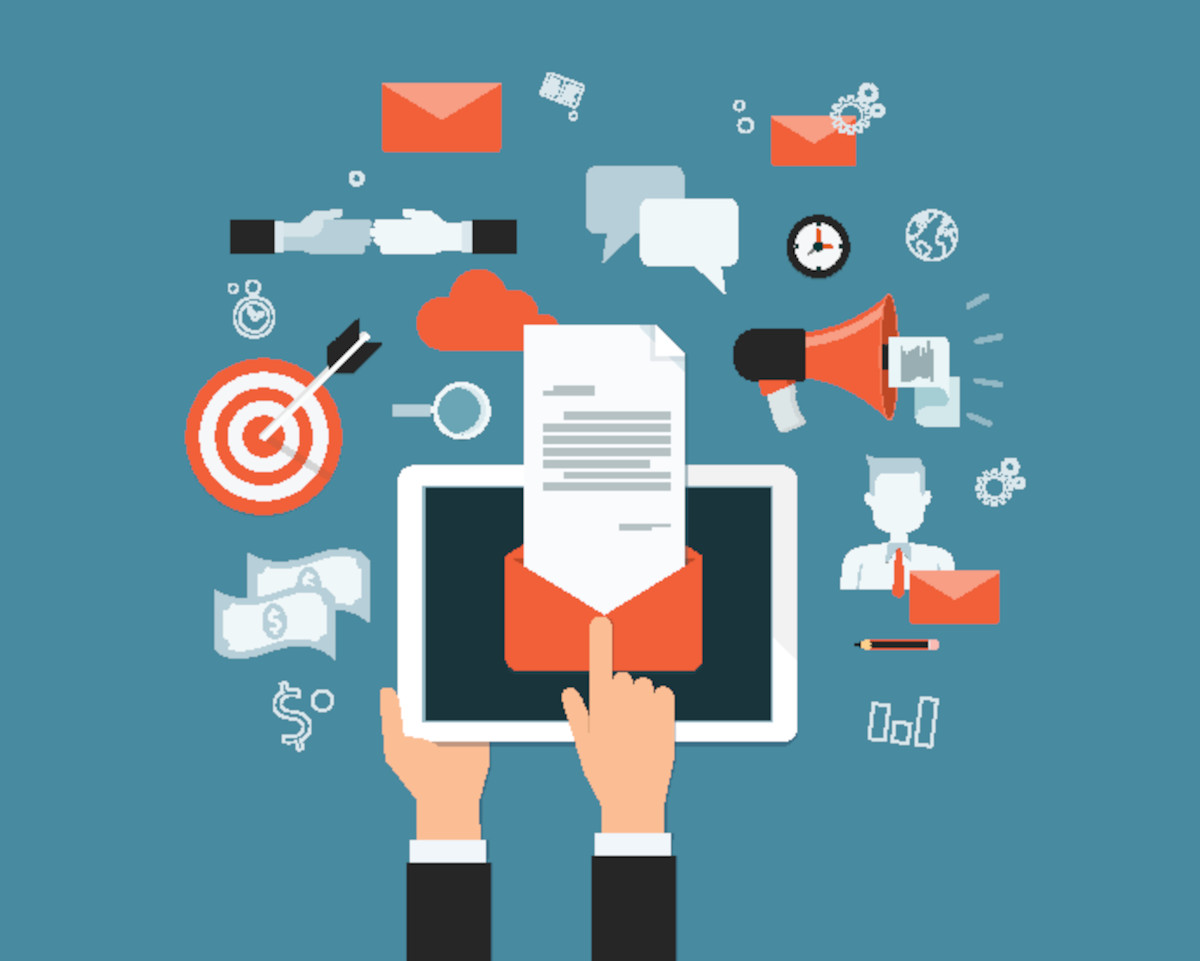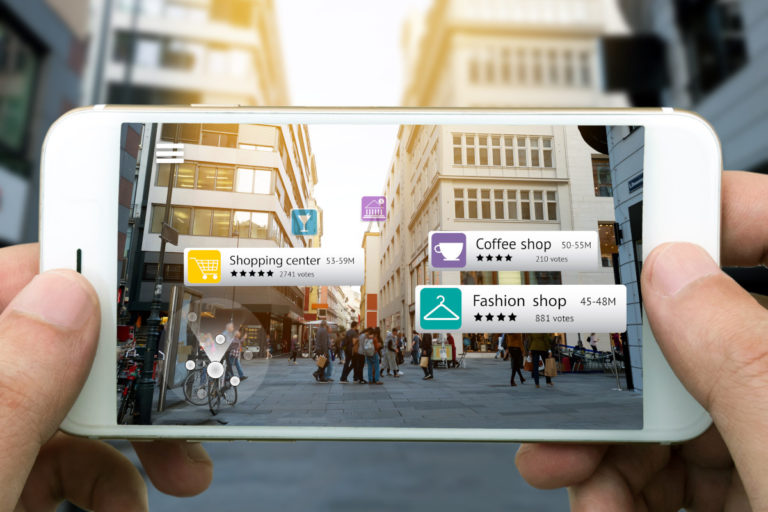When done right, emails can be an incredibly effective marketing tool. Here we’ve outlined some outreach tips and tricks for crafting an engaging email marketing campaign and answered all your questions about how to start utilizing beautiful emails in your marketing efforts.
What is Email Marketing?
Before we can get into the details of how to improve your current marketing strategy, we need to define what email marketing actually is and what purpose it serves.
Dave Charest, director of content marketing at Constant Contact, says that “Email marketing is all about sharing the information [the recipient] needs in the way they prefer it, which includes tone, length, and time of day.”
Email marketing is just one facet of internet marketing or digital marketing: content marketing is done through online marketing channels like websites, blog posts, social media posts, and even augmented reality marketing. Email marketing can include copy like newsletters, company updates, exclusive promotions, and deals — essentially, any direct communication with consumers that isn’t an order confirmation or a response to a question. It is not so much about “official business,” but about connecting with consumers by keeping them informed and updated about your products and services and inviting them to engage with your brand. It can also lead to brand awareness among potential customers.

Why Use Email Marketing?
The end goal of your company’s email marketing campaign is to engage with a target audience, maintaining a consistent presence in their mind and inbox.
Email marketing has a special place in every successful marketing strategy. After all, it has the highest return on investment of all marketing channels. This may surprise you, considering email has been around since 1978. But, on the other hand, there’s a reason it’s stuck around so long.
For one, email marketing has capabilities that surpass other types of internet marketing like social media marketing, making it an invaluable tool for engaging with customers in creative and effective ways. Considering the nature of social media sites like Facebook, you only have about 15 seconds to capture a user’s attention before they scroll on to the next post in their flooding feed.
A brand that only uses social media posts for marketing its products has to come up with some pretty eye-catching material to do that, and even then, you may only get a few subscriber engagements. People scroll past ads, or they get lost in the feed altogether. Email, on the other hand, is sent directly to the subscriber; it doesn’t rely on the user stumbling upon it by luck.
For some businesses email marketing campaigns can be particularly useful, not only to close sales but also to get feedback and build trust: many independent hotels and chains use email marketing as a way to nurture guest loyalty, offering their guests special offers.
What’s more, personalized email marketing is shown to be more effective in increasing the click-through rate. It’s also much more likely that you’ll get responsive emails back when the initial message is personalized to your audience. Automated messages are an element of a drip campaign.
What Can Email Marketing Do for You?
The real question is, what can’t it do? As we mentioned before, email has capabilities other channels don’t. For example, a fashion brand can include high-resolution product images, photoshoots, colorful GIFs, and fun fonts. When done correctly, a well-crafted email marketing campaign can increase sales, boost brand loyalty and awareness, and send important updates to your subscriber — all of this for essentially free, minus the cost of labor. Automated campaigns make delivering dynamic content to your target audience even easier.

8 Email Marketing Tips
Doing an email campaign wrong means missing out on money. You may also break the law. Here are some tips on how to do it right.
Create an Email Marketing Campaign Plan
Excellent execution starts with great planning. Your email marketing campaign needs to be well-strategized. Your strategy should be laid out clearly in an overarching plan that includes what you’re aiming to achieve, how you will achieve it, and how you will measure success. By defining your measure of success, such as click-through rate, you can design an A/B split test. This may be especially useful in understanding where your campaign is succeeding or falling short. Your marketing plan should also include your methodology, objectives, and analysis. With careful preparation and a sense of clearly defined goals, your marketing plan will be much more effective than it would have been if you had foregone this critical step.
Use a Template
Your emails should have a clear, cohesive message in accordance with what is described in your marketing plan. One of the best ways to make sure you hit all the points you outlined in your marketing plan is to create a template that can be used repeatedly (with slight variations). There are dozens of sources that provide free and paid email templates. You want a visually attractive template that allows consumers to connect the email with your brand instantly.
You also want to make sure that the template is conducive to the information you’re trying to get across. Make sure your message comes through clearly with a template that is not unnecessarily complicated. For instance, if you’re not going to be using special features like video, you don’t need a template that has this capability.
Also, check that the template you use is accessible to subscribers’ inboxes on a mobile device. If you’re embarking on a more extensive email marketing campaign, it’s not a bad idea to hire an in-house marketing expert to design your emails for you.
Have a Clear Call to Action
Your email should have a clear call to action, whether that be opting-in for a newsletter, opening a product link, or donating to the charity you’ve partnered with. The objective of most email marketing plans is for the customer to act in a certain way in response to your email. If the desired response isn’t clear throughout your email, you’ll generally have a much lower conversion rate (CR). Call to action in email marketing copy can look different depending on your objective. It also depends on whether you are reaching out to a potential customer, existing customer, or new subscriber. A compelling call to action incentivizes the reader to follow through with what you are instructing them to do. Some examples of typical calls to action in email marketing are: “Stay in the know,” “Get 50% off now,” and “Learn more about our environmentally friendly denim.” These messages usually have hyperlinks, such as to a landing page, or utilize a CTA button.

Nail the Voice, Tone, and Style
Tone and style are an integral part of any solid email marketing strategy. Your brand’s voice is simply what you say. The tone is how you communicate it. Style is more refined. It is your brand’s unique way of communicating with customers. Your tone, voice, and style all need to align. This is especially important not only from a marketing perspective but also from a PR standpoint. You want to be sure that any official communication reflects your brand’s values. Writing in line with those to a customer who shares your brand’s values is highly effective in convincing customers to behave the way you ask them.
Personalize Emails
In the past, emails were used to target a wide range of consumers without naming names. However, it’s become apparent to marketing experts in recent years that customers want a personalized experience. They want a relationship with and connection to the brands they buy from.
Your job, then, is to give your customers that feeling. You want to speak to the customer in your emails — not about them. Simply addressing the customer by their first name goes a long way. This is sure to catch their attention and make them feel special. Make sure you send out a personalized email to each new subscriber.
Add Multimedia Elements
More often than not, consumers won’t engage with an email that isn’t eye-catching. While you don’t need elaborate elements like video, GIFs, or animation in your emails, it certainly doesn’t hurt. Adding multimedia elements like photos, for example, will encourage your customers to examine the email longer, buying yourself more time to make an impression. Look for opportunities to be creative wherever possible. This will help your company stand out from the rest.

Use a Mobile-Friendly Template
Some people (like me) are habitual email checkers. This is the perfect chance to strike, so you need to format your email campaigns to be mobile-friendly. Email marketing is often considered to be at the intersection of internet marketing and SMS marketing, which is why it’s so important to use a template that allows readers to follow click-through links and engage with multimedia elements on their mobile devices.
Make It Easy for Customers to Opt-in (and Out) Of Emails
Your most loyal customers will want a way to stay in the know about new product launches, product tips, special promotions, and the like. Somewhere in your email should be a link to subscribe to your email marketing materials. Usually, this is placed near the bottom of the email. When someone subscribes to your email list, be sure to send out welcome emails.
There legally must be a reasonably convenient way for a subscriber to unsubscribe from your marketing emails. The emails should cease shortly after.
How to Write a Personalized Email Without Spending Much Time on Research
A basic personalized email contains the prospect’s name in the subject line or greeting. A more in-depth email strategizes communications based on buyer personas and what is most relevant to the existing customer.
If you’re a small to mid-sized business with time to reach out to customers on an individual, hyper-personalized basis, consider incorporating the following elements into your copy to an existing customer:
- Address specific pain points
- Highlight a mutual connection
- Give a compliment
- Reference their existing technology
- Triggered emails like birthday emails

A hyper-personalized email can take 10 minutes or more to compose. Depending on your customer base’s size, personalizing each email just isn’t realistic. This is where templates and software come in handy. There are dozens of software available that allow you to tailor your emails to individual customers; some even have a free plan. There are tools out there that do the digging for you and show you everything from the name on their account to what software they use to their buyer persona. Much of this information can then be personalized and sent in automated communication with high deliverability.
What is Better: Outreach Tools or Manual Outreach?
This is a question many businesses ask themselves. The answer depends on your business’s size and industry and what resources you have available to you. Manual outreach is effective, but it’s not the most efficient. If you have the time to personalize every email you send out, then, by all means, do it; just don’t expect to send more than ten emails an hour.

If you’re engaged in a promotional campaign, you’re likely trying to reach hundreds, if not thousands, of potential customers. The scaling just isn’t possible if you’re trying to do this manually. In these situations, marketing automation is the way to go. Luckily, many email outreach tools can accomplish targeted emails for you.
To further automate your communications, you can even implement trigger emails or transactional emails sent when a customer makes a specific action, such as a request to speak with a customer service agent or make a purchase.
How To Answer Rude Emails
Your customer service team, marketer, or whoever manages your email account should be well-trained in responding to rude emails. They are bound to happen, and maintaining grace and civility throughout follow-up emails (even when the customer isn’t doing the same) is vital to keeping your brand’s credibility and good reputation.
Most of all, you want to respond with empathy. Assess the situation, understand where they’re coming from, and decide what the appropriate course of action is. Whatever you do, you want to steer the conversation toward resolution. You should also know when the appropriate time to apologize is.

To Sum Up
There’s a lot to think about when you want to craft the perfect email marketing campaign for your audience. Incorporating the above tips is a great place to start improving your marketing efforts. Once you have your marketing strategy down, consider whether automated emails or manually personalized emails are more strategic and whether this will be a drip campaign. No matter what marketing channel you use, one thing holds true: you want to connect with a potential customer, existing customer, or new subscriber in a meaningful way that will encourage them to engage with your goals, whatever that might be.


